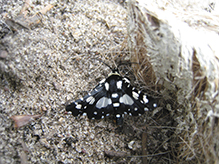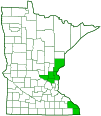mournful thyris
(Pseudothyris sepulchralis)
Conservation • Description • Habitat • Ecology • Distribution • Taxonomy
|
||||||||
| Hodges # | 6077 |
|||||||
Conservation Status |
||||||||
| IUCN Red List | not listed |
|||||||
| NatureServe | NNR - Unranked |
|||||||
| Minnesota | not listed |
|||||||
Description |
||
Mournful thyris is a small, short lived, early season, window-winged moth. It occurs in the United States and southern Canada east of the Great Plains. It is most common in the southeast, from Virginia to northern Florida, west to Oklahoma and eastern Texas. It is uncommon in Minnesota. The entire flight season for mournful thyris is very short, just two to three weeks. In Minnesota that happens in June. For that reason, little is known about the biology of this species, and specimens are rarely found in museum collections. Adults are found in partially shaded forests. They are rarely seen taking nectar of flowers. The larvae feed on the young leaves of willow species. They have been reported feeding on clematis and grape, but this has been shown to be an error because Clematis, Vitis, and Salix often form a plant community. Adults are chunky and 5⁄16″ to ½″ (8 to 13 mm) in length. They have a ⅝″ to ⅞″ (15 to 23 mm) wingspan. They are black with many large and small white spots. Their bold pattern makes them conspicuous in flight and easily identified. The head is black. There is a white spot above each compound eye. The finger-like sensory mouthparts (labial palps) are white. The antennae are long, slender, and black. The thorax is black with a white chest band in front and a large white spot on each side. The abdomen is black with two white bands on the upper side near the middle and a ring of four white spots near the tip. The forewings are black with many spots. The leading edge (costal margin) is slightly convex, making the wing appear flared out at the end. There are four large spots and several small spots in the middle. These spots are glassy and faintly yellowish. There are six dash-like spots on the costal margin. These spots are white and opaque. When in flight, the marginal spots give the wing a ragged appearance. The hindwings are black with a large glassy patch in the middle. Both sets of wings have a checkered black and white fringe. The legs are black and are ringed with white. |
||
Size |
||
Total length: 5⁄16″ to ½″ (8 to 13 mm) Wingspan: ⅝″ to ⅞″ (15 to 23 mm) |
||
Similar Species |
||
Spotted thyris (Thyris maculata) is smaller. The wings are speckled with orange. The white spots are smaller. |
||
Habitat |
||
Partially shaded forests |
||
Ecology |
||
Season |
||
One generation per year: April to July in the south, June Minnesota |
||
Behavior |
||
Adults are active both during the day and at night. |
||
Life Cycle |
||
|
||
Larva Food |
||
Young willow leaves |
||
Adult Food |
||
Flower nectar |
||
Distribution |
||||
|
Sources |
|||
| 11/1/2023 | ||||
Occurrence |
||||
|
||||
Taxonomy |
|||
Order |
Lepidoptera (Butterflies and Moths) | ||
Superfamily |
Thyridoidea | ||
Family |
Thyrididae (window-winged moths) | ||
Subfamily |
Thyridinae | ||
Genus |
Pseudothyris | ||
This species was originally described as Thyris lugubris, then later as Thyris sepulchralis. An analysis of the genus Thyris (Thiele, 1986) separated it into the new genus Pseudothyris based on morphology. Pseudothyris sepulchralis became, and remains, the only species in that genus. |
|||
Synonyms |
|||
Dysodia margaritana Thyris lugubris Thyris sepulchralis |
|||
Common Names |
|||
mournful thyris mournful thyris moth |
|||
Glossary
Costal margin
The leading edge of the forewing of insects.
Labrum
The upper part of the mouth, sometimes considered the lower part of the face, corresponding to the upper lip, on an insect or crustacean.
Palp
Short for pedipalp. A segmented, finger-like process of an arthropod; one is attached to each maxilla and two are attached to the labium. They function as sense organs in spiders and insects, and as weapons in scorpions. Plural: palpi or palps.
Visitor Photos |
|||||
Share your photo of this insect. |
|||||
| This button not working for you? Simply email us at info@MinnesotaSeasons.com. Attach one or more photos and, if you like, a caption. |
|||||
Crystal Boyd |
|||||
 |
|||||
MinnesotaSeasons.com Photos |
|||||
|
|||||

Slideshows |
||

Visitor Videos |
|||
Share your video of this insect. |
|||
| This button not working for you? Simply email us at info@MinnesotaSeasons.com. Attach a video, a YouTube link, or a cloud storage link. |
|||
Other Videos |
|||
| Mournful Thyris Moth (Thyris sepulchralis) - Working Video Nature's Wild Things |
|||
About
Apr 21, 2018 Video 30 Seconds Long 42% Speed - Audio None |
|||

Created: 11/1/2023
Last Updated:


